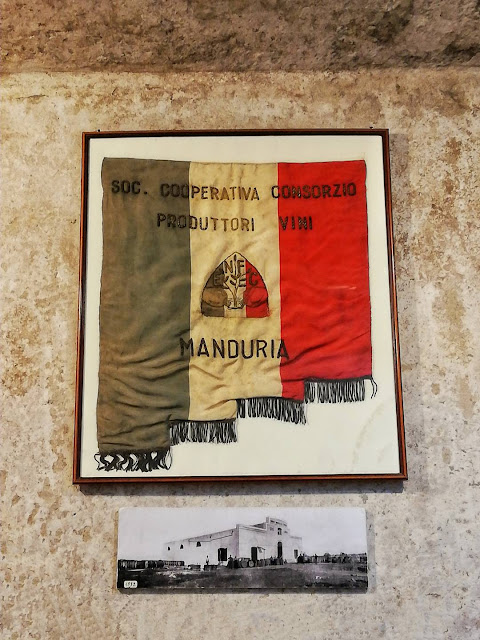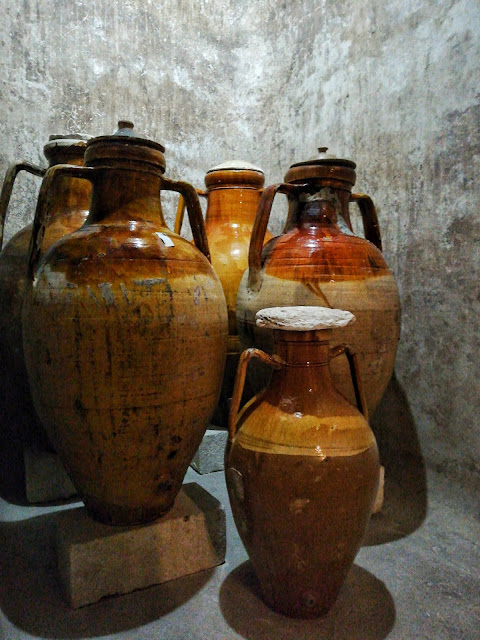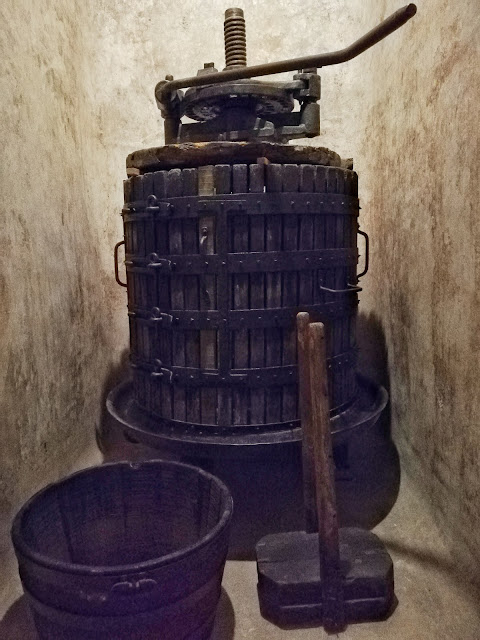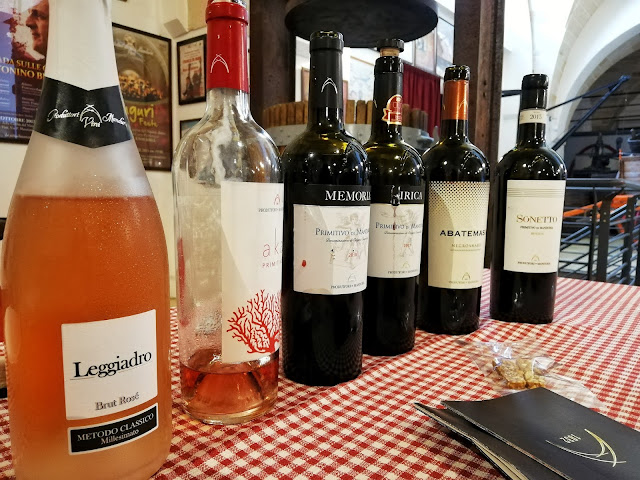Let's meet a famous local product of Puglia and Salento: Primitivo wine of Manduria. We'll meet it in the museum that tells about its history and tradition, ending with a delicious wine tasting. Let's visit the Museum of Primitivo Wine Culture in Manduria!

Leggi in italiano
Do you know Primitivo wine of Manduria?
I know that now you’re giggling thinking that this is a silly question: Primitivo wine of Manduria doesn’t need any introduction, it’s among the most known and appreciated wines in the world. It’s one of the prides of Italy.
You’d be right answering like this, so I ask another question: how much do you know about Primitivo wine of Manduria?
If I should tell you how much I knew about this wine before visiting the Museum of Primitivo Wine Culture in Manduria, I must admit that my knowledge was very limited: a good wine to match mainly with meat dishes. I knew very little of its history and its consortium.
Fortunately, there’s the Museum of Primitivo Wine Culture in Manduria that shares the knowledge about this D.O.C. product and opens a new world to those who get closer to Primitivo wine.
I went to Manduria especially to visit the museum and to discover something more about this local product so appreciated all around the world.
The historic company of the Area of Primitivo Manduria D.O.C.

We pass the gate. Big buildings, huge cisterns, people who go from a part to another of the complex. I imagine how disoriented I must look just arrived, I can guess it from how people who work inside the company look at me. Fortunately, there are indications for the Museum of Primitivo Wine Culture.
We cross the threshold of the museum. Anna Gennari and Katia, the guide that will accompany us in the discovery of Primitivo wine of Manduria, welcome us. This is the oldest cooperative at regional level. It was born in 1932 and 400 farmers are part of it: 400 families that dedicate their lives to the production of Primitivo grape.
Around the third week of August, they start to harvest and bring grapes here, in this structure, where they are selected and processed to produce wine. Does it sound strange the harvest at the end of August? Well, Primitivo variety stands out for its early ripening, thanks to Apulian hot weather. Moreover, the very name says it: primitivo comes from “prima” which means “first”. This grape is the first.

18 towns are part of the Area and they are distributed between the provinces of Taranto and Brindisi. Maduria is the lead.
The Museum of Primitivo Wine Culture
The museum was born in 2000 and its heritage comprises the donations made by the associates of the cooperative.

The visit of the museum is a walk inside the rural life of this area. You go through the rooms where the bedrooms of poor and rich farmers are compared, where there are looms, equipment for dairy production, objects used in everyday life that many people owed in their houses not much time ago, as for example, “capasoni”, that is to say some jars with the dimensions of a person that were filled with wine for 90% and oil for 10%: oil kept air from entering and oxidizing wine, which was tapped from the bottom of the “capasone”.


Then we pass to the heritage linked with wine production. Here, in a room there are some examples of moulding machine and pumps, from the first examples activated by hand to the modern ones, bottling machines.
It’s been beautiful to meet the room where Primitivo wine is resting in barriques: it’s Primitivo Riserva 2018. Katia explains that for a Riserva, the wine must rest in cellar for 2 years, of which 9 months in wood. What we see is almost ready to be bottled. It's impressive to see many barrels carefully placed and to know that they keep a tasty treasure.



The most suggestive thing, which is great according to me, is the location of the museum. To visit it, you go downstairs to enter some rooms carved into rock: they are the old cisterns where wine was stored. There are 30 cisterns, now linked one to another but once they were separated, that were filled from an opening on the roof (or on the floor, if we consider the point of view of those who filled them). Yes, these rooms were full of bulk wine.
They date back to the time when Primitivo wine hadn’t its reputation yet, the consortium wasn’t born and there wasn’t the denomination of controlled origin. Until the 70s , Primitivo wine was considered just for blends, a wine that had to add alcohol and colour to other wines and generally Primitivo wasn’t named in label. The production was oriented more to quantity then quality.
Starting from the 80s, there has been a turnabout that brought Primitivo wine to its fame all around the world: the attention is no more focused on the production of large amounts but on that of a quality product.

We go out of the museum and go upstairs to discover that we are on the opposite side of the room where the visit started. That maze of tanks occupies all the space beneath the local that welcomes the sale of wine. Now it’s time for wine tasting.
The wine tasting
Before coming here, I’ve never had the pleasure to participate in a wine tasting. I admit that this might have been the part of the visit that made me really curious. Living in the province of Taranto, the consumption of Primitivo wine for me it’s not something new. I thought I knew what to expect from the tasting. I’ve never been so wrong!

A table set with 3 glasses waits for us. Katia puts in front of us a brochure with the wines of the winery: “What would you like to try?” Maybe I’ve been indiscreet but I couldn’t avoid to answer: “We’re here to know Primitivo wine better… Can we taste all of them?” and Katia pleased me.

I’d never have imagined to drink different wines, from happy hour to dessert, all starting from a base of Primitivo. We started with the bubbles of a Prosecco, we passed from the fruity notes of pomegranate of a rose wine that was a joy for your taste buds and your eyes, with its reddish nuances, to Primitivo wine in the wholeness of its round and enveloping taste to end with the surprise of a “dolce naturale”, that according to me tastes like Christmas atmosphere, with its sweet and spicy notes of dried figs and cinnamon.

This visit gave me a completely new perception on the world of Primitivo wine of Manduria, on its history, on the passion of its producers. When we talk about Manduria and its local products, we immediately think about wine, but if you really want to meet it and to know it, I suggest you, without any doubt, to come and visit it in the Museum of Primitivo Wine Culture of Manduria.
The Museum is in Manduria in via Fabio Massimo, 19. For more information and to book a visit, you can visit the website www.museodelprimitivo.it
I thank Anna Gennari and Katia very much for having us and for having been so kind and available in guiding us in this journey in the history and the tradition of Primitivo wine.

Commenti
Posta un commento
Feel free to leave a comment!
I would be glad to know your opinion! ;)
Thank you! :)